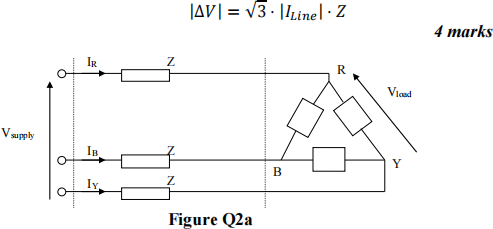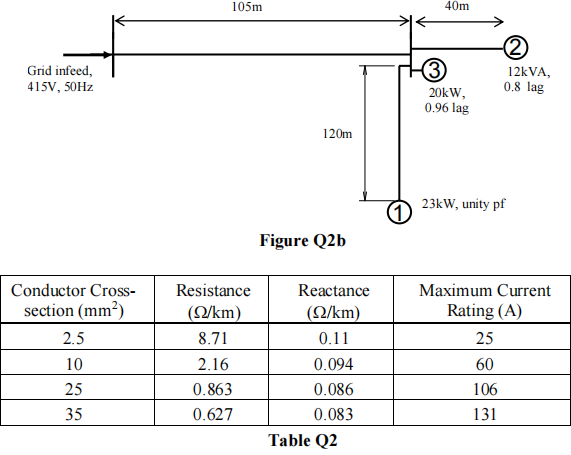EE311 ELECTRONIC AND ELECTRICAL PRINCIPLES 3 May 2017
Hello, dear friend, you can consult us at any time if you have any questions, add WeChat: daixieit
EE311 ELECTRONIC AND ELECTRICAL PRINCIPLES 3
Date: xx May 2017
PART A
Attempt the following compulsory question
Q1. (a) List and briefly explain a few advantages (at least two) of a three- phase electrical system compared to the equivalent single-phase system. This can be related to generation, transmission or utilisation of electrical energy. 2 marks
(b) The simplified load profile shown in Figure Q1 represents the demand at a substation over a 24 hour period. Calculate the corresponding load factor. 2 marks

(c) Sketch the typical architecture for a rural power distribution network, and explain what changes might be made in order to improve its reliability of supply. 2 marks
(d) A three phase delta connected, 460V, 945rpm, 50Hz, 6-pole wound rotor induction motor, with the rotor windings short-circuited, find the start-up current when starting at full voltage. R1 = 0.20![]() R2 = 0.20
R2 = 0.20![]() X1 = X2 = 0.95
X1 = X2 = 0.95![]() . 2 marks
. 2 marks
(e) A full loaded transformer has a copper loss of 440W and iron loss of 350W. Determine the total loss when the transformer is half loaded. . 2 marks
[Total: 10 marks]
Attempt ONE further optional question from this part.
Q2 (a) Considering a single phase load and supply, it can be shown from simple circuit analysis that the cable voltage drop is given by:
ΔV = VSupply − VlOad = 2IZ
where Z represents the impedance of each cable conductor.
For the three phase case shown in Figure Q2a, perform a similar analysis and prove that for the balanced three phase case,

(b) For the THREE phase system and loads shown in Figure Q2b,
determine suitable cable sizes such that the voltage at each load remains within statutory limits. Use the cables sizes and parameters given in Table Q2. 12 marks

(c) Describe what you understand are the key characteristics of a typical transmission network, and explain how you expect such networks to change in the future. 4 marks
[Total: 20 marks]
Q3. A small part of a three-phase network supplying a number of loads is shown
in Figure Q3. The grid infeed fault level is 950MVA.
(a) Using a common base of 50MVA, determine the resulting per unit
values for the network components shown in Figure Q3. Show these on a sketch of the single line diagram. 5 marks
(b) Calculate the steady state fault level at busbar D in the network shown
in Figure Q3 under the following two conditions:
(i) the generator at D and the motor at B are disconnected (ii) the generator at D and the motor at B are all connected 12 marks
(c) Without calculation, describe how the fault level at busbar D would be affected if an additional line was built connecting busbars B and C. Clearly explain your reasoning. 3 marks
[Total: 20 marks]

PART B
Attempt the following compulsory question
Q4. (a) Write down the expression for the voltage reflection coefficient of a transmission line at the boundary between the line and the signal- source and explain the symbols used. 2 marks
(b)
Write down the expression for the evaluation of the ‘characteristic impedance’ of a transmission line and explain the symbols used in the expression. 2 marks
(c)
A plane wave travelling in air is incident (normal to the surface) upon a perfect conductor. If the electric field of the incident wave is given by Ei = ![]() 377cos(2
377cos(2![]()
![]() 10 t
10 t ![]() 20
20![]() z)9 V/m, obtain the time domain expression for the magnetic field of the reflected wave. 2 marks
z)9 V/m, obtain the time domain expression for the magnetic field of the reflected wave. 2 marks
(d)
A plane wave in air is incident (normal to the surface) upon a lossless, nonmagnetic medium with εr =25. Determine the average power density of the reflected waves. E0i =10 V/m. 2 marks
(e) Select all graphs in Figure Q4e which do not represent the light output of a Laser Diode.

2 marks
[Total: 10 marks]
Attempt ONE further optional question from this part.
Q4. (a) Find the phasor of the following time functions i(t) = 2cos(Ot + 3![]() /4). 2 marks
/4). 2 marks
(b) Using phasor domain representation, write Maxwell’s equations for the isotropic and homogeneous medium characterized by c, μ, ![]() . 4 marks
. 4 marks
(c) The magnetic field of the plane wave traveling in a medium with cr = 9 made of nonmagnetic, nonconducting material is H = ![]() 2cos (2
2cos (2![]() 109 t - ky), (A/m) (see coordinates in Figure Q5c):
109 t - ky), (A/m) (see coordinates in Figure Q5c):
(i) Find the phase velocity u, wave number k, angular frequency O, and medium impedance n for this medium;
(ii) Find wave’s direction of travel;
(iii) Find the corresponding vector E;
(iv) Find the corresponding vector S; what is vector S called and what its meaning is?
(v) Consider xyz coordinates shown in Figure Q5c and indicate the orientation of vectors E, H, S, and ^;
(vi) What is the average power density SAV of this wave?

14 marks
[Total: 20 marks]
Q6. (a) Show that the input impedance of a transmission line (with
characteristic impedance ZO and which is terminated with a load ZL) is equal to ZO when ZL = ZO . 4 marks
(b) A distortionless line satisfies the condition R’C’ = L’G’ . If such a
transmission line has R’ = 2 Ω/m; L’ = 200 nH/m; G’ = 800 µS/m; and C’ = 80 pF/m, determine:
(i) The characteristic impedance, ZO, of the line
(ii) The attenuation constant, α, of the line (you may assume that R’ = α ZO )
(iii) The propagation velocity of a signal if the dielectric medium of the line has a relative permittivity of 2.5 12 marks
(c) If a 10 V pulse (with a pulse width of 10 μs) were to be injected into the above-mentioned transmission line that is 100 m long and terminated in its characteristic impedance, write down the expression you would use to predict the magnitude of the pulse at the end of the line. Hence, evaluate this magnitude. 4 marks
[Total: 20 marks]
2023-07-15